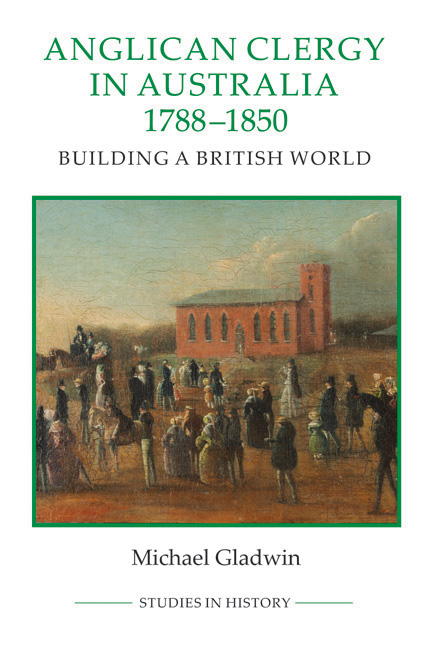Book contents
- Frontmatter
- Dedication
- Contents
- List of illustrations
- Acknowledgements
- Abbreviations
- Map
- Introduction
- PART I SINEWS: FUNDING, RECRUITMENT, BACKGROUNDS AND MOTIVATION, 1788-1850
- PART II CLERGYMEN IN COLONIAL AUSTRALIA, 1788-1850
- 4 Ecclesiastical roles: rites of passage and public worship
- 5 Flogging parsons? Chaplaincy, the magistracy and civil roles
- 6 Clergy, culture and society
- 7 Clergy and indigenous peoples
- PART III SCENES OF COLONIAL CLERICAL LIFE: AUSTRALIAN CLERGYMEN AND VOLUNTARISM, 1836-50
- Conclusion
- Bibliography
- Index
5 - Flogging parsons? Chaplaincy, the magistracy and civil roles
from PART II - CLERGYMEN IN COLONIAL AUSTRALIA, 1788-1850
Published online by Cambridge University Press: 05 December 2015
- Frontmatter
- Dedication
- Contents
- List of illustrations
- Acknowledgements
- Abbreviations
- Map
- Introduction
- PART I SINEWS: FUNDING, RECRUITMENT, BACKGROUNDS AND MOTIVATION, 1788-1850
- PART II CLERGYMEN IN COLONIAL AUSTRALIA, 1788-1850
- 4 Ecclesiastical roles: rites of passage and public worship
- 5 Flogging parsons? Chaplaincy, the magistracy and civil roles
- 6 Clergy, culture and society
- 7 Clergy and indigenous peoples
- PART III SCENES OF COLONIAL CLERICAL LIFE: AUSTRALIAN CLERGYMEN AND VOLUNTARISM, 1836-50
- Conclusion
- Bibliography
- Index
Summary
The vignette of Thomas Rogers, with which this book began, disclosed his warm relationship with his convict flock and his critique of the convict system. It suggests a different relationship from that usually presented by historians, where it has long been overshadowed by the ‘flogging parson’ tradition in Australian historiography. The pre-1850 clergy have been portrayed as uncritical agents of both the ruling classes and the brutal machinery of the convict system. In contrast, Rogers's experience indicates two themes. One is the suggestion of a closer and more sympathetic relationship between convicts and clergy at the grass-roots level than most historians have presented, particularly in relation to parson-magistrates. The second is raised by the publication of William Browne's letter as a polemic against convict transportation. That letter was only one of a raft of publications that reveal clergymen and parson-magistrates as journalists, activists and intellectuals, campaigning along distinctly humanitarian lines for structural reform of the convict system itself. In turn, these two themes offer a basis for a fresh assessment of the relationship between Australian clergy, government and convicts before 1850.
Parson-magistrates and convicts: local interaction
There are several reasons for the narrow way in which the history of clergymen and convicts has been constructed. In the first place, the historical and popular orthodoxy concerning flogging parsons has been extrapolated from the careers of influential individuals, namely Marsden and, to a lesser extent, Knopwood. It has failed to take into account the ten other parson-magistrates in Australian colonies before 1850, not to mention 224 other non-magisterial Anglican clergymen. Clergymen ceased serving as magistrates in eastern colonies in 1827, but were still serving as magistrates in Norfolk Island and Western Australia up to 1850. South Australian clergymen unanimously rejected an offer of magistracies in the late 1840s. Much of the historiography has also overlooked substantial evidence for positive interactions, or adopted an unduly suspicious hermeneutic with insufficient regard for context.
- Type
- Chapter
- Information
- Anglican Clergy in Australia, 1788–1850Building a British World, pp. 114 - 128Publisher: Boydell & BrewerPrint publication year: 2015



